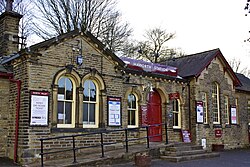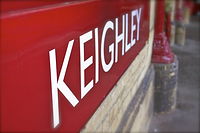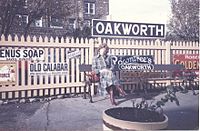Keighley and Worth Valley Railway
| Keighley and Worth Valley Railway | |
|
Yorkshire | |
|---|---|
 Haworth Station | |
| Gauge: | standard |
| No. of stations: | 6 |
| Track: | 5 miles |
| Headquarters: | Haworth |
| Information | |
| Website: | kwvr.co.uk |
The Keighley and Worth Valley Railway is a branch line five miles long that served mills and villages in the Worth Valley and is now a heritage railway line in the West Riding of Yorkshire. It runs from Keighley (53°52’2"N, 1°54’1"W) to Oxenhope (53°48’54"N, 1°57’6"W). It is a standard gauge railway and connects to the national rail network at Keighley railway station.
History
Inception and building of the branch
In 1861, a civil engineer named John McLandsborough visited Haworth to pay tribute to Charlotte Brontë and was surprised to find that Haworth was not served by a railway. He decided that this should be changed and put forward a proposal for a branch running from the station at Keighley to Oxenhope, which was warmly received by a number of mill owners and other influential people in the area as well as the Midland Railway, the owners of the railway through Keighley. The branch served 15 mills around its terminus as well as others on the line, so it was perceived as being unlikely to fail through lack of traffic.
J McLandsborough was appointed acting engineer; whilst J S Crossley of the Midland Railway was appointed consultant engineer. McLandsborough had hitherto been predominantly engaged with water and sewerage engineering, but had experience of building the Otley and Ilkley Railway. The first sod was cut on Shrove Tuesday, 9 February 1864.
The railway was built as single track, but with a trackbed wide enough to allow upgrading to double track if the need arose[1] and the engineers estimated work that it would take one year to complete, but there were some delays: contractors were delayed getting possession of the land and apparently a cow ate the plans of the line somewhere near Oakworth. More seriously problems arose digging the tunnel at the direct south end of Ingrow West, which manifested itself in that the tunnel walls, when bored, were oozing quicksand requiring that piles be driven down to the bedrock to support and stabilise the tunnel (the railway company had to pay £1,980 in damages for the damage the resultant vibration and earth movement caused to the Wesley Place Methodist Church).[1]
In 1866 the track was complete and tested with a locomotive from Ilkley, which took nearly 2 hours to get from Keighley to Oxenhope, but just 13 minutes to get back.[1]
The opening ceremony was held on Saturday 13 April 1867. Unfortunately, the train got stuck on Keighley bank and again between Oakworth and Haworth, necessitating splitting of the train before carrying on with the journey. Finally, on 15 April 1867, public passenger services on the Worth Valley commenced.
Operation
The line was operated by the Midland Railway, who owned most of the rail network in the area, and was eventually bought by the Midland in part due to interest from the rival railway company, the Great Northern. Upon sale of the railway, the mill owners made a profit, which was unusual for many lines of that type, as (for strategic reasons) the Midland wanted to prevent the GN from taking over its territory. Later the line became part of the London, Midland and Scottish Railway and part of BR on nationalisation in 1948.
A deviation was built on the line as a condition of the purchase by the Midland Railway. The need for the deviation was to avoid a large wooden trestle viaduct that crossed a mill pond, as the locals believed the viaduct was unsafe, and supposedly many alighted at Oakworth and continued on foot to Haworth to avoid crossing the viaduct. The original design for the deviation was to skirt the mill pond then through a cutting to rejoin the original formation. However, during construction the material in the cutting proved to be unstable, resulting in the construction of the short Mytholmes Tunnel. The original trestle viaduct can be seen in a picture hanging in the booking hall of Oakworth station.
Closure
British Railways closed the line in 1962 and their last scheduled passenger train ran on 31 December 1961.
Reopening

A preservation society was formed which bought the line from BR and reopened it in 1968 as a heritage railway. The line is now a major tourist attraction operated entirely by volunteers and carries more than 110,000 passengers a year.
The Railway Children (1970) was largely filmed on the Keighley and Worth Valley line, and ever since has attracted interest in the railway. The Damems Signal Box had to be built to cope with the extra traffic generated by the film.
The Keighley and Worth Valley Railway is currently one of only two preserved railways which operates a complete branch line in its original form, the other being the heritage Ecclesbourne Valley Railway in Wirksworth, Derbyshire.
Operation as a preserved line
On 10 July 2008, the Duke of Kent visited the railway following the 40th anniversary of its reopening.[2][3][4] While at the railway, the Duke travelled on a specially prepared "Royal Train", consisting of tank locomotive 41241, an LMS Class 2MT, pulling a single carriage, The Old Gentleman's Saloon, as featured in The Railway Children, which is a former North Eastern Railway directors Saloon. While visiting, the Duke travelled in the carriage and on the locomotive footplate.
Stations and facilities

- Keighley (Mainline connections to Leeds, Bradford, Skipton, Carlisle, Lancaster, Morecambe and London King's Cross)
- Station restored to BR 1950s condition complete with cast-iron platform canopy on Platform 4, as once existed on all of the platforms
- Ingrow (West) (access to the Vintage Carriages Trust's Museum of Rail Travel)
- Damems (smallest standard-gauge railway station in Britain with waiting room, booking office, signal box and level crossing)

- Oakworth (location for the filming of The Railway Children. Restored to Edwardian condition and lit by gas lamps)
- Haworth

- Oxenhope (Terminus of the branch. Carriage & Wagon Maintenance department, not open to the public)
Commuter use
On weekends - in particular Saturday mornings, local residents who live in Oxenhope, Haworth, Oakworth and Ingrow catch the early morning diesel service to Keighley, returning later on steam hauled services. During the weekday outside of the summer months, locals instead use the local bus services which typically take twice as long to reach a destination than any proposed commuter rail service, due to the nature of heavy traffic into and out of Keighley.
As a privately owned heritage railway, the line does not specifically serve commuters; however, a study by Ove Arup & Partners looked at the feasibility of a daily commuter service between Oxenhope and Keighley in 2009.[5] After the first stage of the study was released, Metro stated concerns about a lack of funding and available rolling stock, meaning that services are unlikely to run in the short to medium term.[6]
Another study recently undertaken on behalf of the Worth Valley Joint Transport Committee has found that running up to four commuter trains each way in the morning and evening is feasible.[7]
Rolling stock
The Keighley and Worth Valley Railway has a large collection of both steam and diesel locomotives, as well as supporting carriages and other rolling stock. The railway has amassed a large collection of Vintage Carriages over the years. Some are used to carry passengers on specially selected open days.
The railway owns three rail mounted cranes: a 10T Grafton steam P-Way crane, a 15T Taylor Hubbard diesel P-Way Crane and an ex LMS 45T steam breakdown crane. Currently only the 15T Taylor Hubbard crane is in traffic. Furthermore, there are a variety of wagons used by the civil engineering department, largely at either Oakworth or Ingrow West.
Use in film, media and television
The line and its stations has been used in numerous period film and television productions including the film The Railway Children.[8]
In the 1960s (shortly before the preserved line re-opened), a ITV advertisement on chocolate cookie biscuits, featuring Ronnie Corbett, was filmed along the line and at Mytholmes Tunnel (between Oakworth and Haworth). A steam train carries (at the front end) out of the tunnel a shocked Corbett holding onto the handrail of the engine. The locomotive used was Pug 51218.[9]
In 1976, The railway and Haworth railway station appeared in the premier episode of a Granada TV sitcom called Yanks Go Home (set in 1942), in which a group of US Army Air Force pilots arrive by train and alight at the station (Haworth) and are stationed in a small Northern town in Lancashire, North-West of England, during the Second World War.
In 1979, an episode of the long-running UK TV sitcom Last of the Summer Wine was filmed partly along the Worth Valley route, in which the three main characters Compo, Foggy and Clegg visit and then to attempt to stop a runaway steam train having pulled the brake on purpose (and then only to drive upwards and downwards). The locomotive used was Pannier 5775 in its London Transport guise as L89.
Outside links
| ("Wikimedia Commons" has material about Keighley and Worth Valley Railway) |
- Keighley and Worth Valley Railway website
- Ingrow Museum of Rail Travel - Vintage Carriages Trust
- Ingrow Loco Museum - Bahamas Locomotive Society
- British Railways in 1960 - Keighley to Oxenhope
- Lancashire & Yorkshire Railway Trust
References
- ↑ 1.0 1.1 1.2 History of the Keighley and Worth Valley Railway
- ↑ HRH The Duke of Kent visits Haworth Haworth Village Website, News, 10 July 2008, accessed 10 November 2008
- ↑ Court Circular, past events, Thursday, 10 July 2008 www.royal.gov.uk, 10 July 2008, accessed 10 November 2008
- ↑ Full-steam ahead on the royal railway! The Telegraph and Argus, 10 July 2008, accessed 10 November 2008
- ↑ "Commuter trains earmarked for the Worth Valley?". Rail Magazine (618). 20 May 2009.
- ↑ "Commuter service plan hits buffers". Bradford Telegraph & Argus (Newsquest Ltd). 6 June 2009. http://www.thetelegraphandargus.co.uk/news/4423910.VIDEO__Commuter_service_plan_hits_buffers/. Retrieved 8 June 2009.
- ↑ "Keighley and Worth Valley Railway could carry commuters". BBC. 21 January 2011. http://news.bbc.co.uk/local/bradford/hi/people_and_places/history/newsid_9369000/9369367.stm. Retrieved 2 February 2011.
- ↑ "screenonline: Railway Children, The (1970)". screenonline. British Film Institute. http://www.screenonline.org.uk/film/id/531815/index.html. Retrieved 27 November 2009.
- ↑ The Golden Age of Steam Engines, No. 2 – Branching Out (at 27mins 30secs). BBC4, broadcast 27 October 2013; first broadcast 17 December 2012
